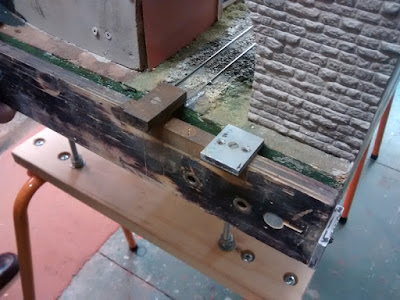Workshop brickwork.
Crane mechanism
Gas holder base and adjacent trackwork
Water tank
A quiet session this week as we were all continuing with ongoing projects.
Stephen continued to apply plasticard brickwork to the workshop, including window arches and cills. The door arches were more tricky - what would they have been made of? In the end, he opted for 'posh' brick-clad lintols (the easy option). The damaged roof tile sheeting was removed and some corrugated plasticard sheeting trialled.
 |
| The fiddleyard now provides a nice work area at stool height, for which the knees are very grateful. |
Geoff worked on the gas holder base area, as discussed the previous week. Adjacent ground was pared down and new plaster added to the holes. Different textures of dust and ash were pressed in, as an experiment, but these were almost entirely sucked away when the hoover cleaned up. The plaster will be over-painted when Stephen returns the bottles of acrylic paint.
While working in the area, Geoff noticed the water tank on the hill was not level, confirmed by spirit level. As the tank hadn't been glued down yet, it was removed and packing added both over and under the MDF base. The consequential gaps in the brickwork were filled with strip brickwork.
A discussion ensued about the route of pipework for the tank. The intake would, presumably, come from higher up the hillside i.e. off the board. The supply to the gasifier was less obvious. The equipment has been loosely re-positioned, and a quick check through the blog photos showed that there never was a pipe from the tank. Brain-cells having been disturbed, we recalled that a pipe encased with timber/insulation was discussed years before, but the connection point was unknown. Geoff will research further, and suitable valve details will be sought-out at ExpoNG, over the coming weekend.
 |
| No supply pipe from the tank. Note the new steps. |
Laurence had also brought the Cottesmore interface jigs/templates, that he was to deliver to the new owner of Lansdowne Green (see last weeks post). For posterity, these were photographed in the closest appropriate locations. In both cases, new locator pins prevent them being fitted correctly.
The hole drilling / track template was placed next to the bridge, which would have been a Cottesmore interface. The track is still in the original position, but the hill profile has been modified.
The hill profile template was positioned at the end of the new platform. The track at the board joint has been moved and the hill has been cut back to form the road, but it demonstrates its original use.




















































